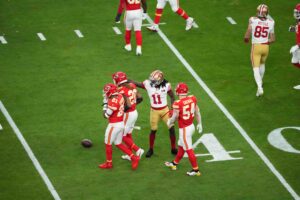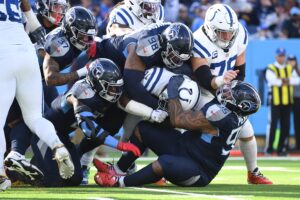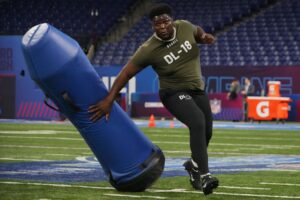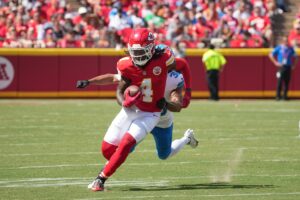The injury statistics don’t usually make much of a splash, but with so much focus on the NFL concussion issue and concussion protocol, more of us are paying attention to them than ever. This is incredibly frustrating for all parties concerned. Fans and players have to resign themselves to the fact the sport they love causes lasting harm to its players. Some would say that people get injured just going to the grocery store every day. True, but is it going to be a lasting injury that will erase your memories? It’s not quite as simple as all that. Not even the stats are simple. By rights, they should show a decrease in concussions, due to rule changes applied in the early 2000s. But they don’t. Turns out that there are about a zillion different variables to consider when compiling the data. In the meantime, the league doesn’t seem to be making headway.
The NFL Concussion Issue: Continuing to Make Headway
The Core Issue: Concussions
While the league’s ratings continue to climb ever higher, researchers cry foul ever louder. They want us to know that football can lead to a wide range of long-term brain conditions. Retired players have repeatedly said that in hindsight, the risk outweighed the rewards. As a result, they would rather see their children grow up to be educated professionals than football players. They wouldn’t want to put their kids through what they had to go through themselves. They point out that greater emphasis must be placed on being taught to hit with your shoulders. Even though those are the guidelines already, according to players, it’s not translating over to all practice fields. Additionally, players simply do not believe the league has their backs when it comes to health and safety. And can you blame them, especially what with the league not being exactly “forthright” about concussions in recent memory?
Making Heads or Tails of Concussion Numbers
Since 2002, the league has made 47 rule changes designed to reduce injuries to the head and neck. If these rule changes actually are effective, the statistics should start to show a drop in concussions. The latest numbers indeed show a small overall decrease in concussions from 2015 to 2016. Hopefully the numbers reflect a league that is getting better at this. But while it should be a simple thing to prove that concept, such things can be very difficult to quantify. A couple of years ago, the league recorded a fairly substantial rise in concussions. We still don’t know what caused that spike, for a variety of reasons. For example, statistics could have been raised because teams are getting better at spotting and reporting concussions. Or the stats could have been skewed because some injuries don’t end up on the team injury report.
Recording – and Reporting – the Statistics
Why are the team injury reports of any importance to stats? Because team injury reports are the only publicly available data on who was sidelined by a “head injury.” Combine that with the fact that teams report head injuries in multiple ways, ranging from “concussion” to simply “head.” Those are straight up reporting issues, and only some of the many imperfect reporting practices convoluting the matter. Additionally, teams do not release injury reports until week one of the regular season. Concussions from training camp are thus left off the list, just missing in action on that all important report. And what about when a team is on bye and an injured player recovers in time for the next game? Well, that injury goes unreported, too. And so you see that the collection of statistical data alone can become quite convoluted.
Self-reporting: A Sign of Culture Change
The 2016 season is the first time the league has seen a “significant number” of self-reported concussions. Although it sounds contradictory, this should actually be viewed as a positive. You have to interpret that as an improvement to the concussion protocol and an increase in the number of concussions actually identified. It can also be attributed to a change of culture amongst the players. Perhaps self-reporting is no longer prohibited by some type of macho code where you’re supposed to just “suck it up”. A change in culture, however, isn’t something that’s simple to quantify. To compound the problem the league did not track self-reported injuries in the past. Again, the reporting practices cause the data to be murky. It then becomes difficult to compile data to give us a definitive answer as to cause and effect. Until the reporting process is more complete, we’re stuck here, folks.
The Laws of Physics vs. Concussions
Once you get past the reporting issues, you also have to add in a number of other variables. For example, is there evidence that abbreviated breaks between game days lead to an increase in injuries? In this case, the answer is apparently “no.” Is the playing surface to blame? Apparently this particular variable produces a “yes.” Last Word on Sports has looked at the increase in weight between players from the 1960 and current players before. This is another variable to consider, and a formidable one at that. While players aren’t just heavier, they’re also faster and stronger. The force of a hit depends on players’ weight and speed, and on how he stops moving. Simply put, when a relatively light player of the 1960s laid out his opponent, he would have done so with fewer pounds of force than the relatively heavier player of today.
Playing With Variables
Presumably, then, hits are now harder, and harder equals more potential for injury. At least that part of the stats is simple, right? Not so fast! Player weights have changed from the 1960s to now, but only marginally between the 1990s and now. If it were just about size and speed, the numbers should have stayed static since the 90s. They have, however, not. Instead, the league has seen an increase in the number of severe injuries in recent years. (The definition of a “severe injury” here is one which results in surgery or in eight or more days of missed playing time.) In college football, the use of helmet sensors shows hits have gotten gradually stronger over the last ten years. And so, the issue of concussions in the NFL remains exactly that, an issue, even 47 rule changes, hundreds of lawsuits and countless research papers later.
Moving Forward With Full Contact
But we are making headway? The league has made changes, which include how the game is coached and played. The NFL is looking to discipline dirty, injury-causing plays out of the game. And the latest statistics do show a drop in concussions. Even though it’s only slight, it is still a drop. As mentioned, there seems to be a bit of a shift in culture among players. Additionally, the players who will be coming up from now on will have been taught under the new rules. They’ll have learned from an early age how to play safe. Theoretically, that ought to shift the culture even farther. The reporting issues can likely be improved, especially now that the pressure is on. Still, football is a full contact sport. There will be injuries. The goal now is to keep them from being “severe” and lifelong ones.






